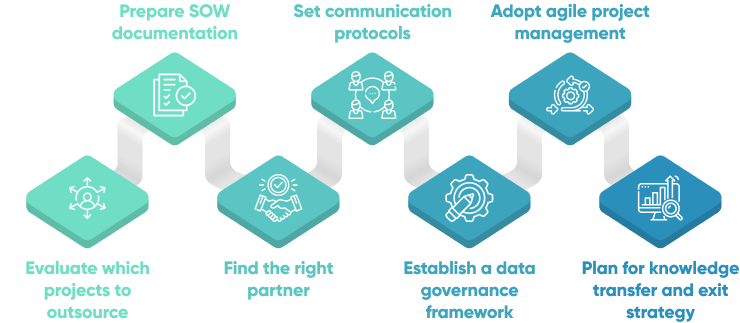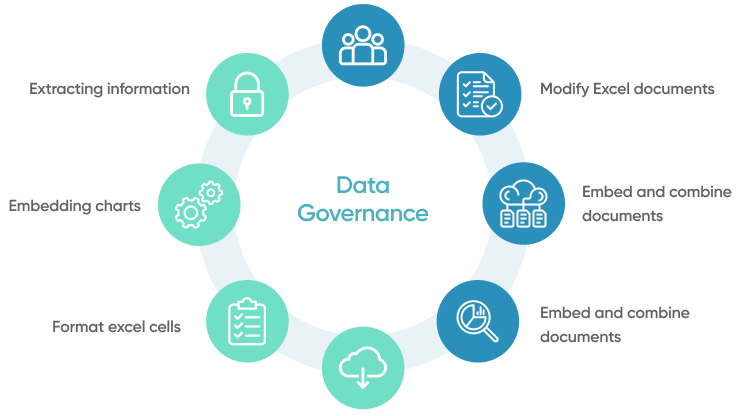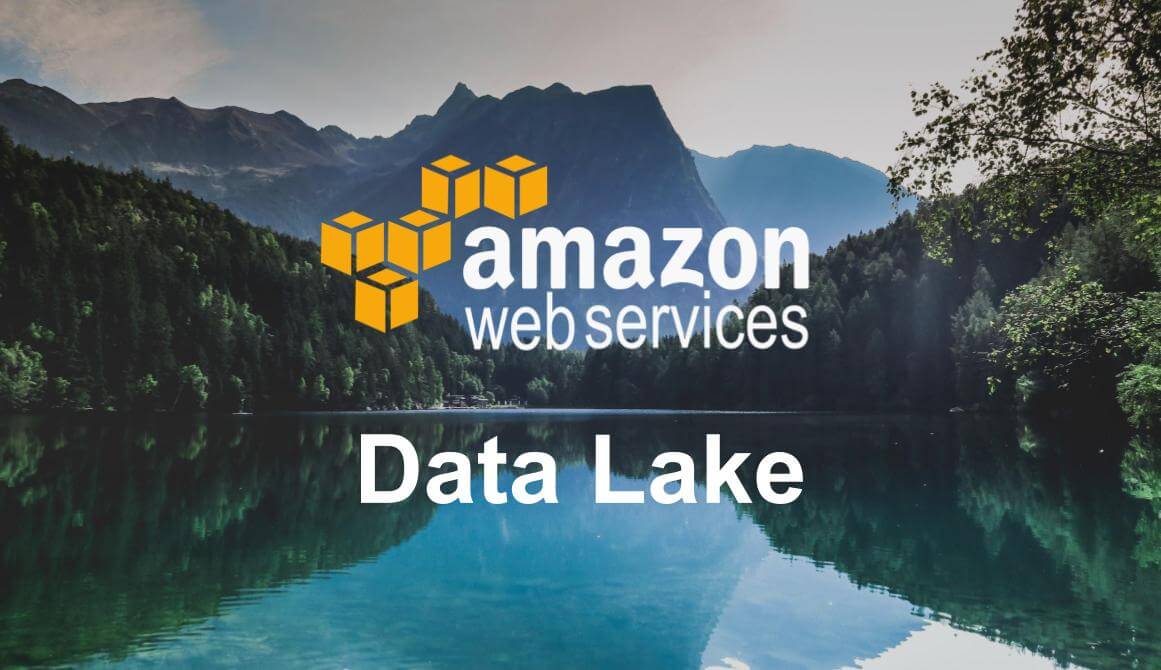According to a recent study, data engineers are in short supply, and businesses face challenges in finding qualified data specialists. Outsourcing data engineering and data science tasks can be a strategic solution to in-house talent shortages, providing access to specialized skills and expertise while allowing you to focus on your core business operations.
In this article, we'll guide you through the essential steps to successfully outsource data engineering projects, so you can harness the benefits of specialized expertise while maintaining control and efficiency.
- Why Outsource Data Engineering?
- 7 Steps to Outsource Data Engineering in 2024
- 1. Evaluate which projects you outsource
- 2. Prepare scope of work documentation
- 3. Find the right data engineering partner
- 4. Establish clear communication protocols
- 5. Establish a data governance framework with the vendor
- 6. Adopt an agile project management approach
- 7. Plan for knowledge transfer and exit strategy
- Conclusion
Why Outsource Data Engineering?
Outsourcing unlocks a range of benefits to businesses of all sizes. Some of the key reasons why businesses today are looking externally for data engineering services include:
- Cost efficiency: Companies can avoid the expenses associated with hiring in-house staff, especially in a very competitive job market. With outsourcing, the vendor takes on the burden of acquisition, hiring, training, and on-going infrastructure costs.
- Flexibility and scalability: Companies gain the agility to scale their data needs up or down based on project requirements and business growth. They can quickly adapt to market changes or demands without being constrained by a fixed workforce.
- Access to specialized skills: The complexity of data engineering often requires specialized skills. Outsourcing provides access to machine learning engineers and data scientists with the latest knowledge and experience in cutting-edge technologies.
- Focus on core business functions: By delegating data engineering to trusted partners, companies can invest in their core business functions and accelerate business growth.
7 Steps to Outsource Data Engineering in 2024
Outsourcing data engineering can offer businesses a number of benefits, but the process requires careful planning and strategic execution. The following steps ensure a structured approach to engaging with external vendors.

Evaluate which projects you outsource
Before diving into outsourcing, it’s crucial to determine which data engineering projects are suitable for outsourcing in the first place. This evaluation helps ensure you make strategic decisions that maximize benefits while minimizing risks.
Start by assessing the complexity of the project. High-complexity projects that require specialized expertise or advanced technologies may benefit significantly from outsourcing, whereas low-complexity tasks might be better handled in-house to maintain control and reduce costs. Additionally, consider the scope and duration of the project. Short-term projects, such as one-off tasks, are ideal candidates for outsourcing as they don’t justify long-term in-house resource allocation. For long-term projects, reflect on whether they align with your strategic goals and if you want to maintain long-term control and oversight.
Outsourcing data engineering might be a good fit for:
- Projects that exceed your team's technical capabilities or bandwidth
- Short-term or one-off projects that don't justify long-term in-house resource allocation
- Tasks that need quick turnaround times and immediate deployment
PRO TIP: Evaluate the cost-effectiveness of outsourcing with a service provider versus handling the project internally. Consider both direct costs and indirect costs such as training and infrastructure. Determine which projects will provide the highest return on investment if outsourced, allowing you to allocate your budget more effectively.
Read More: 6 Steps to Accurately Estimate Software Development Costs
Prepare scope of work documentation
The Scope of Work (SOW) document is a cornerstone for any outsourced data engineering project. It provides a detailed description of the tasks, deliverables, and timelines involved, ensuring that all parties understand and agree on the project requirements.
A well-crafted SOW helps to align all stakeholders and set clear expectations. It ensures that every aspect of the project is considered, aiding in keeping the project on budget and on schedule. Moreover, when working with an external vendor, an SOW acts as a legally binding document that holds the vendor accountable for delivering the agreed-upon outcomes.
Key elements of a SOW:
- Project objectives: Define the high-level goals of the data engineering project, providing a clear description of what the final data infrastructure or solution will look like and its purpose. Specify how the project will support business goals such as improved data analysis, data processing, data validation, reporting, or data-driven decisions to generate valuable insights.
- Deliverables: Specify the outputs expected from the project, breaking down deliverables into phases if applicable. Define success criteria for each deliverable, such as data pipelines, ETL processes, data warehouses, or dashboards.
- Schedule: Outline the high-level project duration and timeline and identify dependencies, responsible parties, and key milestones to ensure timely delivery and coordination.
- Functional requirements: Describe the functional aspects of the data engineering solution, including data integration processes, data transformation rules, data storage solutions, and access methods. Include specific requirements for data collection, data cleaning, and loading operations.
- Non-functional requirements: Detail the attributes describing how the data engineering solution should perform, covering aspects like data security, data volume handling capacity, system reliability, scalability, performance, and ease of use.
- Assumptions: Document assumptions about the data sources, types of data such as raw data or unstructured data, technology stack, approvals, and post-implementation support. Ensure alignment with outsourcing partners regarding data availability, data quality, and integration points.
- Risks: Identify and document potential risks, assessing their likelihood and implications. Include risks related to data quality, data privacy, system integration, project timelines, and resource availability.

Find the right data engineering partner
Selecting the right data engineering outsourcing partner is crucial for driving business growth and ensuring the success of your project. With a clearly defined scope of work, you’ll be able to identify a partner who aligns with your goals and requirements. Consider the following criteria to find the right outsourcing partner:
- Domain knowledge and expertise: Look for a partner with technical proficiency and a deep understanding of your industry. Their project management capabilities and business acumen should align with your specific needs, ensuring they can deliver projects faster and more effectively.
- Documented development methodology: Ensure the partner follows a structured development process, such as Agile or Scrum. A well-documented and executed methodology improves efficiency and keeps the project on track.
- Transparent pricing: Choose an outsourcing partner who prioritizes clarity in their pricing structure. They should be open to discussing all costs comprehensively, including upfront costs and any ongoing fees.
- Client reviews: Examine client reviews to gauge the partner’s reliability, professionalism, and the quality of their work. Positive feedback from previous clients is a strong indicator of their capability to deliver successful projects.
- Communication skills: Prioritize teams with strong communication skills, as effective collaboration is essential for the success of data engineering projects. Clear and consistent communication helps in understanding project requirements and addressing issues promptly.
PRO TIP: There are plenty of resources where you can find data engineering vendors::
- Use Google to search for data engineering companies. Both paid and organic results can be helpful. From individual company websites you can get information on their services, industries they work with, their previous clients and their work processes.
- Browse software development review and rankings websites. One of the most popular of them is Clutch. You can view the search results by location, minimum project size, average hourly rate, industry focus, and more.
Read More: How to Find Software Development Partners - Steps-by-Step Guide
Establish clear communication protocols
Effective communication is the backbone of any successful outsourcing relationship, especially in data engineering projects where complexity and precision are crucial. Establishing clear communication protocols ensures that all parties are aligned, reducing misunderstandings and enhancing collaboration.
Here are some key elements to include in your communication protocols:
- Designate a primary point of contact from both your team and the outsourcing partner. This person will be responsible for coordinating communication and ensuring timely responses to queries and concerns.
- Establish a routine for status updates. Decide on the frequency (daily, weekly) and the format (written reports, video calls). These updates should cover key metrics, milestones achieved, and any blockers or risks identified.
- Create a structured process for giving and receiving feedback. Ensure that there is a clear path for reporting issues and that feedback is acted upon promptly. This helps in maintaining transparency and continuous improvement.
Establish a data governance framework with the vendor
Implementing a robust data governance framework is essential when outsourcing data engineering projects. This framework ensures that your data is managed securely, consistently, and in compliance with relevant regulations, protecting your business and maximizing the value of your data assets.

To establish an effective data governance framework with your vendor, focus on these key areas:
- Clearly outline data ownership and management responsibilities. Specify roles for data stewards, custodians, and users within both your organization and the vendor’s team to ensure accountability and proper data handling.
- Establish criteria for data accuracy, consistency, and reliability. Implement security protocols, such as encryption and access controls, to protect data from unauthorized access and breaches. Ensure the vendor adheres to these standards and conducts regular security audits.
- Develop policies that comply with relevant regulations like GDPR, HIPAA, or CCPA. The vendor should be familiar with these regulations and capable of implementing practices that ensure compliance, protecting your data and mitigating legal risks.
- Implement role-based access controls to ensure that only authorized internal resources can view or manipulate the data. This minimizes the risk of data breaches and unauthorized data manipulation.
Adopt an agile project management approach
Agile methodologies provide the flexibility to adapt to changing requirements, enhance collaboration, and improve responsiveness. When outsourcing data engineering, it’s critical to look for a partner who is well-versed in Agile best practices and who can seamlessly integrate with your team. They should facilitate iterative development, maintain open and continuous communication, and foster a collaborative environment that promotes quick adjustments based on feedback. This ensures that your project remains on track and aligned with your business objectives, delivering effective and timely results.
PRO TIP: Every team interprets “agile” differently. Take the time to thoroughly understand what agile practices the outsourcing company has in place and how they might fit with how your team works.
Read More: How to Create a High-Performing Cross Functional Agile Team?
Plan for knowledge transfer and exit strategy
Planning for knowledge transfer and having a clear exit strategy are critical components of any outsourcing arrangement. These steps ensure that your business can seamlessly continue operations if the outsourcing relationship ends and that valuable knowledge and processes are retained within your organization:
- Ensure all processes, systems, workflows, and methodologies are documented in detail. This should include step-by-step guides, technical specifications, and project milestones. Comprehensive documentation makes it easier for your internal team to understand and manage the project independently.
- Conduct frequent sessions where the vendor shares updates, insights, and training with your internal team. These sessions should cover new developments, troubleshooting techniques, and best practices. Regular knowledge sharing keeps your team informed and capable of taking over when necessary.
- Establish and agree upon detailed procedures for the transfer of data, documentation, and responsibilities in the event of project termination. This should include timelines, specific deliverables, and points of contact.
- Develop a strategy to maintain ongoing services and system integrity during the transition period. This might involve cross-training your team, setting up interim support mechanisms, and ensuring backup resources are available.
Conclusion
Outsourcing data engineering can be challenging for many data teams, but with the right process in place, it can be a strategic move. If you take the time up front to develop clear workflows and find the right partner, you’ll set yourself up for a long-term successful partnership.
At SoftKraft we offer data engineering services to help teams modernize their data strategy and start making the most of their business data. We’ll work closely with you to understand your unique business challenges and map out a strategic solution that addresses your specific needs. Reach out today!







